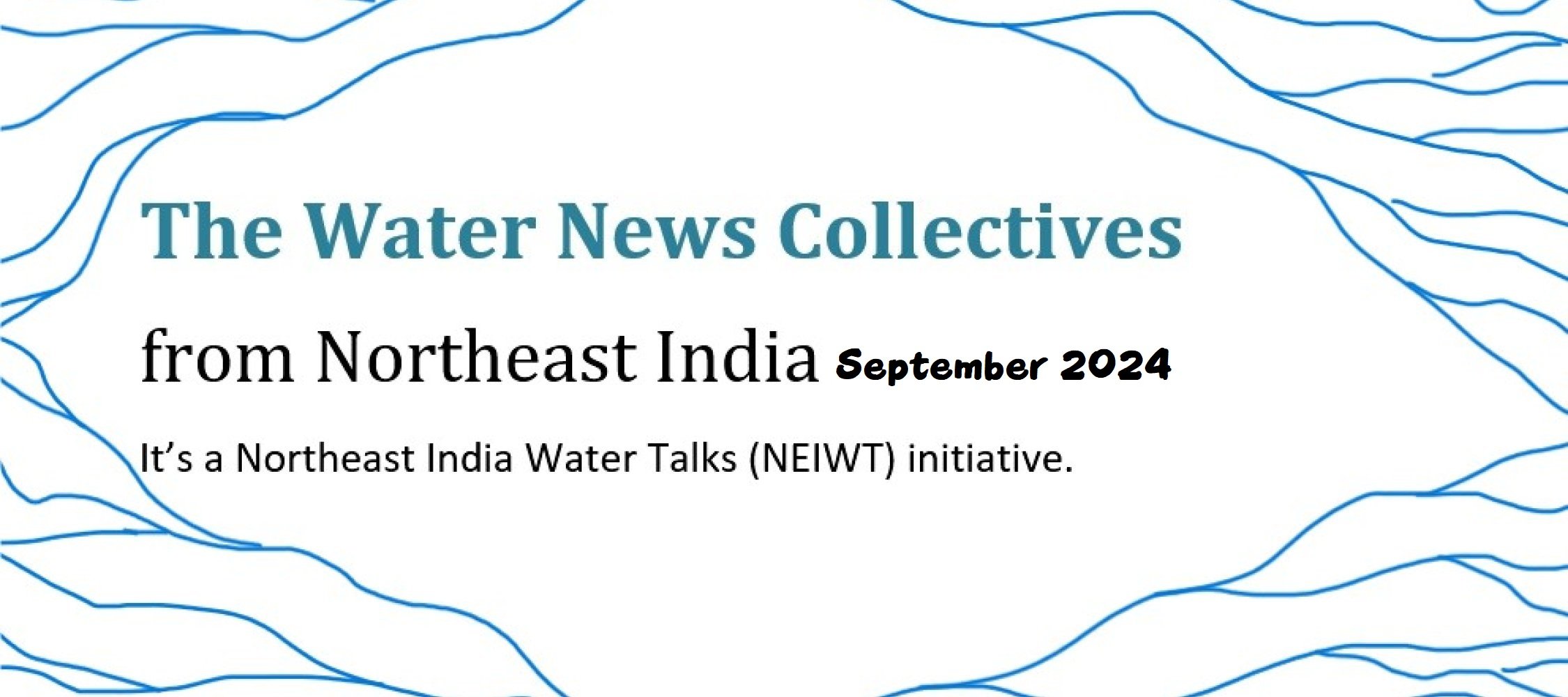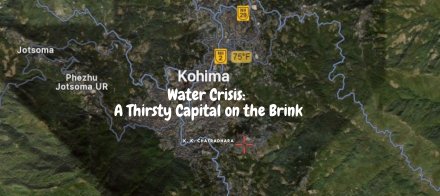 |
The Water News Collectives
from Northeast India (September 2024)
It’s a Northeast India Water Talks (NEIWT) initiative.
The heat wave and the water scarcity were the focus point of the month.
Assam:
Increasing heat waves cause water shortage problems in the paddy fields of Assam:
In September 2024, Assam experienced significant heat waves that highlighted the alarming effects of climate change on the region's weather patterns. Traditionally known for its monsoon rains, this month saw unusually high temperatures, causing discomfort and health risks for residents. The mercury soared well above the seasonal average, disrupting daily life and straining the state's agricultural practices. Paddy fields, which typically thrive in the moist conditions of September, faced adverse effects due to the intensified heat, leading to concerns over crop yields and food security. Farmers reported stunted growth and water shortages as the rising temperatures accelerated evaporation rates in irrigation systems, exacerbating the existing challenges of managing water resources.
This unusual weather pattern in Assam is a reflection of broader climate change trends that have increasingly impacted the region. Experts warned that such heat waves are becoming more frequent and intense due to rising global temperatures, leading to unpredictable rainfall and extended dry spells. The ramifications of these changes are particularly concerning for vulnerable populations who depend on agriculture for their livelihoods. Health officials noted a rise in heat-related illnesses, stressing the need for public awareness campaigns and preventive measures to protect at-risk communities.
Farmers faced challenges in maintaining adequate water levels for their crops, which affected paddy yield and overall agricultural productivity. Some areas reported stunted growth in rice plants due to insufficient water, leading to concerns about food security and economic stability for local farmers.
Water Crisis in Guwahati: Guwahati faced a severe water crisis that raised concerns among residents and local authorities alike. Prolonged dry spells and increased demand for water, exacerbated by a growing population, led to significant shortages in several neighbourhoods. Many households experienced erratic water supply, forcing them to rely on alternative sources or purchase water at inflated prices. The situation was further complicated by aging infrastructure, which struggled to meet the needs of the city. In response, the municipal government began implementing emergency measures, including tanker services and public awareness campaigns on water conservation. As Guwahati grapples with this pressing issue, the need for sustainable water management solutions has become increasingly urgent to ensure a reliable supply for its residents.
Sources:
https://www.downtoearth.org.in/climate-change/why-is-assam-boiling-hot-heat-dome-effect-say-experts
https://assamtribune.com/assam/number-of-days-with-abnormal-temperature-increasing-in-state-1552833
https://indianexpress.com/article/india/heatwave-alert-assam-guwahati-met-centre-northeast-9352333/
Sikkim:
Heavy Rains in Sikkim Trigger Landslides, Damage Roads and Bridges:
In September 2024, Sikkim experienced heavy rainfall that caused widespread disruption across the state, triggering numerous landslides and damaging essential infrastructure, including roads and bridges. The intense precipitation, part of the seasonal monsoon, resulted in soil saturation and instability, leading to landslides in several districts, particularly in the North and East Sikkim regions. These landslides not only blocked vital transportation routes but also posed significant risks to the safety of residents and travellers.
The impact of the landslides was felt acutely along major highways and rural roads, which were rendered impassable due to debris and fallen rocks. Key access routes, including the National Highway 10, experienced significant disruptions, hindering the movement of goods and services. The local administration promptly mobilized teams to clear the debris and restore access, but the on-going threat of further landslides due to continuous rainfall complicated these efforts. The damage to roads not only disrupted daily life but also affected tourism, which is a crucial part of Sikkim's economy.
Additionally, the heavy rains had a severe impact on the Teesta River, which runs through Sikkim and is known for its unpredictable behavior during monsoon seasons. The river saw a rapid rise in water levels, leading to fears of flash floods that could endanger nearby settlements. Authorities issued warnings to residents living along the riverbanks to remain vigilant and evacuate if necessary. The rising waters also threatened to erode riverbanks, further destabilizing the surrounding landscape and infrastructure.The local government and disaster management agencies were activated to assess the situation and implement emergency measures. Evacuation plans were put into place in vulnerable areas, and temporary shelters were established for those displaced by landslides or flooding. Community awareness programs were launched to educate residents about safety precautions and the importance of heeding warnings during extreme weather events.The combination of heavy rainfall, landslides, and rising river levels served as a stark reminder of the vulnerabilities associated with climate change and environmental degradation.
Sources:
Nagaland:
Water Crisis and Sanitation Issues in Nagaland: In September 2024, Nagaland is experiencing a critical water crisis, particularly evident in Tuensang town. This situation has intensified in light of the Dr. A To Trophy scheduled from September 17 to 24, exacerbating an already precarious water supply. The crisis highlights significant challenges related to water availability and sanitation, raising urgent concerns among residents and local authorities. Tuensang town, known for its vibrant community and cultural significance, is facing severe water shortages as the Dr. A to Trophy approaches. The influx of visitors for the event has increased demand, further straining the already limited water resources. Erratic rainfall patterns this monsoon season have left many areas in Nagaland with insufficient potable water, impacting both urban and rural populations.
Rural communities, in particular, are suffering as traditional water sources—often their primary supply—have dried up or become contaminated. The lack of access to safe drinking water poses significant health risks, especially for vulnerable populations such as children and the elderly, who are more susceptible to waterborne diseases. The water crisis is compounded by declining sanitation conditions across Nagaland. Initiatives like the Swachh Bharat Mission, designed to improve hygiene and sanitation infrastructure, have been stymied by funding shortfalls and bureaucratic inefficiencies. Many communities still lack basic sanitation facilities, exacerbating the contamination of local water sources and facilitating the spread of diseases.
In Mukokchang, reports of corruption related to water and sanitation projects have surfaced, further complicating the situation. Allegations indicate that funds meant for improving water infrastructure have been misappropriated, hindering efforts to address the crisis effectively. Local NGOs and community organizations have stepped in to fill the gaps created by inadequate governmental responses. These groups are working to raise awareness about the importance of sanitation and hygiene, but their efforts are often limited by a lack of resources and reach. A coordinated approach involving both government and non-governmental organizations is essential for addressing the intertwined issues of water supply and sanitation effectively.
Recent Landslides and Water Issues in Nagaland: In the first week of September 2023, Nagaland faced a tragic landslide event along National Highway 29 (NH-29), resulting in the loss of six lives due to incessant rainfall. This incident has not only led to fatalities but has also disrupted vital road communication between the state capital, Kohima, and the commercial hub, Dimapur. The situation raises significant concerns regarding infrastructure resilience and disaster preparedness in the region. The devastating landslide occurred late Tuesday night in Pherima, impacting multiple locations along NH-29. In addition to the six confirmed fatalities, which included individuals who had stopped at a roadside eatery, the landslide caused extensive damage to several houses, roadside hotels, and vehicles. Among the deceased were Khriesangulie (46) and his mother-in-law, Anhieü (60), who were traveling with their family when the disaster struck. The impact was severe, with reports indicating that a portion of the highway collapsed into the nearby Chathe River, exacerbating the situation.
The landslide left scores of vehicles stranded, with approximately 150 vehicles—primarily goods-carrying trucks bound for Manipur—caught in the chaos. The road has been completely cut off for vehicular movement, creating logistical challenges for both residents and businesses reliant on this critical transport route. The Nagaland State Disaster Response Force (SDRF) launched search and rescue operations early Wednesday morning, aided by volunteers from nearby villages. Despite the challenging conditions, the team successfully retrieved the six bodies from the debris. Meanwhile, efforts to clear the road and restore access are ongoing but are complicated by the severity of the landslides. Official sources indicate that restoring normalcy on NH-29 will take considerable time.
Chief Minister Neiphiu Rio expressed deep concern over the destruction caused by the incessant rainfall and urged the National Highways & Infrastructure Development Corporation Limited (NHIDCL) for immediate restoration measures. In a statement on social media, he emphasized that authorities were on-site to assess the situation and provide assistance to those affected. The landslide incident highlights broader issues related to water management and disaster preparedness in Nagaland. The region is particularly vulnerable to heavy monsoon rains, which not only trigger landslides but can also lead to flooding and water contamination. Communities often rely on traditional water sources that become compromised during such events, raising the risk of waterborne diseases. In light of the recent disaster, there is an urgent need for improved infrastructure, effective drainage systems, and comprehensive disaster management plans. Strengthening these areas is crucial to minimize future risks and protect vulnerable populations. The recent landslides along NH-29 in Nagaland serve as a stark reminder of the challenges posed by natural disasters and inadequate infrastructure. As the state grapples with the aftermath of this tragedy, it is imperative for both state and central authorities to prioritize investment in resilient infrastructure and effective water management strategies. A coordinated response involving community engagement, governmental support, and infrastructural improvements will be vital to ensure the safety and well-being of residents in the face of future challenges. The tragic loss of life must prompt immediate action to bolster Nagaland's preparedness for such events in the future.
Sources:
https://www.ndtv.com/topic/nagaland-landslide
https://www.newsonair.gov.in/nagaland-mudslides-and-landslides-hit-nh-29-cm-takes-stock-of-disaster/
https://nagalandpage.com/district-water-sanitation-mission-meet-held-in-kohima/
https://nagalandtribune.in/tuensang-town-to-face-water-shortage-due-to-dr-t-ao-trophy-2024/
https://nagalandtribune.in/kohima-district-water-sanitation-mission-meeting-held/
https://www.eastmojo.com/nagaland/2024/05/01/nagaland-water-shortage-crisis-grips-kohima/
https://nagalandpost.com/index.php/2024/04/29/water-scarcity-grips-kiphire-town/
End of the September 2024 update…
North East India Water Talk Water News Collectives (September 2024)
We are Water, and we keep an eye on water!
Compiled by: K. K. Chatradhara, Bhaskar Jyoti Borah.
This newsletter is a monthly publication of the North East India Water Talks (NEIWT). We cover all aspects of water, including reports, paper clips, research papers, incidents, and activities done by different actors, such as government institutions, non-governmental organizations, etc.
What is published here is not the position of NEIWT.
Each month's first day of news will feature the latest happenings from the previous month.
Published: 2nd Oct 2024


